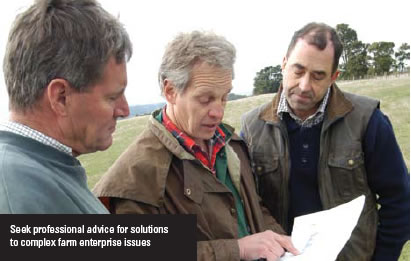 |
 |
Assessing the financial, social and environmental impacts of enterprise change and new technologies requires significant analysis and planning
|
 |
Determine the life of the investment in any large and complex changes to assess how long it will take to break even |
 |
Seek professional help |
|
 |
Introduction
Assessing competing investment options for a farm’s scarce resources involves quantifying or qualifying:
- Net change in expenses — taking account of any increased costs (cash and non-cash costs such as additional owner- labour requirements or depreciation on plant and equipment) and reduced costs.
- Net change in income — accounting for increased income and any trade-offs, such as lower wool income if there is an increased focus on lamb production.
- Scale of the investment — for example, an investment in pasture improvement will need to be accompanied by an often greater investment in additional livestock and may require increased management inputs.
- Likely repayment period — for the investment and the cash flow implications, taking account of the climatic and production risks involved.
- Life span of the expected benefits from the investment — for example, an investment of $50,000 in a change that produces a benefit of $15,000 p.a. over 10 years ($150,000 in total) is better than an investment of the same amount with the same benefit but only for 5 years ($75,000 in total).
- Nature of, and additional exposure to risk associated with any new or alternative enterprise.
Key decisions, critical actions and benchmarks
Farm businesses most often involve multiple enterprises with complex interactions between them. To ensure that returns are improved over the whole farm, the calculations are best done on a whole-farm basis.
Two planning tools are provided in this procedure.
The partial budgeting (tool 1.11) is most suited to significant investment decisions (buying more land, embarking on a new enterprise, re-fencing the farm, or embarking on a major revegetation program) where a more rigorous planning process is required. It is often demanded if significant borrowings are needed. Such significant decisions do not happen often on most properties. There may be only one or a few per decade.
Tool 1.11 shows a worked example of a partial budget and the subsequent return on investment calculation. This can be used as a template for analysing straightforward adjustments to the business. Additional references are listed in the signposts.
If the partial budget in tool 1.11 is not appropriate to the situation, or to the level of information or skills at your disposal, the SGS one-page planner (tool 1.12) might be more suitable. It is a less formal tool that allows quantitative and qualitative information to be included. This tool is most suited to important decisions that affect the operation of the farm – you might make several of these a year.
The focus is on decisions that can have flow-on effects across the system, or decisions in areas where you lack confidence to do something ‘off the top of your head’. Examples of such decisions might include, for example, fertiliser applications, changing grazing strategies, selecting different rams, re-sowing a pasture, etc.
Tool 1.12 provides a planning template and a worked example (assessing a decision to renovate a pasture) and provides the opportunity to incorporate non-financial information (such as environmental impacts). The tool can also be used to assess environmental projects that may have little financial analysis.
Seek professional assistance if you need tools for whole-farm analysis across multiple enterprises to quantify the complex interactions between:
- Marginal costs
- Marginal income
- Discounted cash flow analysis
- Time to break even
- Lifespan of the investment and
- Relative return on capital invested.
Signposts  |
Read
The Farming Game – Agriculture Management and Marketing, 2nd Edition (2005) Bill Malcolm, Jake Makeham and Vic Wright, Cambridge University Press – to help determine comparative return on investments.
Sustainable grazing - a producer resource, explains how grazing management techniques can be used to achieve increased productivity and reduced methane emissions per hectare. There are 5 sections to this online resource:
- Running a sustainable grazing business
- Climate variability - using water wisely
- Healthy fertile soils
- Productive persistent and profitable pastures
- Grazing management
Visit: www.mla.com.au/research-and-development/environment-sustainability/sustainable-grazing-a-producer-resource
Attend
The MLA EDGEnetwork® program is coordinated nationally and has a range of workshops to assist sheep producers. Contact can be made via:
Local Rural Financial Counsellors can help you:
- Identify financial and business options for your enterprise
- Find private training and agricultural service providers across Australia who deliver training courses and offer advice on the incorporation of new technologies or new enterprises into farming businesses.
Find your local Rural Financial Counsellor by calling 1800 686 175 or visiting the website: http://www.agriculture.gov.au/ag-farm-food/drought/assistance/rural-financial-counselling-service
Agricultural Consultants (outside WA) – go to the Ag Institute Australia website at www.aginstitute.com.au and click on the consultants register tab.
Australian Association of Agricultural Consultants (AAAC) WA – www.aaacwa.com.au. Search this site for consultants and advisors in WA.
|

|